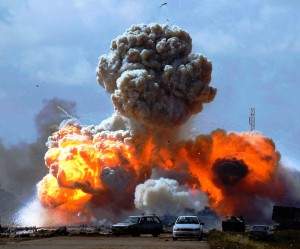Exposing composite photos
October 31, 2023 by Thomas Wictor
I was absolutely sure that the world press published massive numbers of composite photos during Operation Protective Edge. Though I couldn’t prove it technically, I relied on my knowledge of munitions. Yesterday a professional photographer from the Czech Republic sent me a message explaining how I can determine whether or not a photo is real.
“Although I have no relation to the Middle East,” he wrote, “(except that our tiny country was among the very few that supported Israel since its day one in Operation Balak) it hurts me seeing the constant injustice.”
See, Israelis and Jews? You have great friends who are so morally outraged that they’ll help debunk the lies once and for all.
You need photo-enhancement software to do this. I use ArcSoft PhotoStudio.
It’s very basic, but it serves my needs. My computer is set so that all jpeg and TIFF files are automatically imported into PhotoStudio. If I download an image from the Internet, and it’s a jpeg or a TIFF, when I open it, I’ll see this.
The green arrow marks “Enhance” from the menu. When I click that, I get these options.
To see if a photo is a composite, we use “Equalization,” also called “Equalize” in other photo-enhancement software. Equalization is a redistribution of the brightness in an image. The purpose is to reduce the range from light to dark by spreading the intermediate brightness evenly throughout the photo. You use it only when there’s very high contrast.
The more expensive photo-enhancement software allows you to control the degree of equalization. Mine has only one setting. These are Turkish assault troops of World War I, about to head off to Galicia in 1918.
After equalization.
Here’s a totally unretouched image of Orson Welles Leonardo DiCaprio blathering about anthropogenic global warming in hell at the UN before he flies off in his carbon-spewing private jet, frantically gobbling fatty foods in an effort to assuage the shallow guilt he feels at being so grossly overpaid.
Leonardo equalized.
Notice that the both pictures remain unified wholes. You can tell that none of the elements in the photos were added later, since the transformation created by equalization is uniform. All the parts are affected the same way.
Now the acid test. First I had to find an image that I knew to be genuine and unretouched. It took two hours to locate a photo of an atomic explosion that hadn’t been enhanced. This is “Priscilla,” from Operation Plumbbob (May 28-October 7, 1957).
Priscilla equalized.
Nothing leaps out as having been superimposed. All edges blend into each other.
Here’s an explosion photographed during the overthrow of Libyan dictator Muammar Ghaddafi (February 17 to October 20, 2023).
After equalization.
As “Hollywood” as that photo seems, it’s genuine.
Finally, a real mushroom cloud.
The same mushroom cloud equalized.
Almost no difference.
Fake photos that the press says are real
This is from the recent American bombing of Kobane, Syria.
I knew it was fake, and now I can prove it.
It’s a total composite. You can see the edges of the superimposed parts, and the fireball has become a cartoon.
One from Gaza.
Equalization shows that the fireball is fake, and most of the smoke has been added.
Gaza again.
After equalization, we see that everything except for the buildings is fake.
The Islamic State fighter who ran through a storm of steel fragments from a 1000-lb (460-kg) GBU-32 and emerged unscathed (or decapitated)?
After equalization, we see perfectly delineated areas of whitish yellow.
I’m calling it a fake. High quality, but still fake.
Next is a tanker explosion in Afghanistan.
When you equalize it, you see that the fireballs are superimposed composites.
The two men marked by the green arrows aren’t reacting because in reality there was no giant explosion.
More tankers burn merrily in Afghanistan.
Except that none of the fire and smoke is real.
Look at the hard edges. The fireball in the middle looks like cauliflower. What actually happened is that the photographer shot the aftermath and added the melodrama in order to be paid more.
Back to Gaza.
I knew this wasn’t caused by Israeli munitions. The size of the explosion and color of the smoke made me think it was Hamas IEDs.
It’s fake. Equalization reveals that the explosion is a separate element, and there are three layers of buildings.
Although the explosion is real, it was enlarged, and a flying palm tree (green arrow) was superimposed. The red arrows show “artifacts,” the wavy lines that appear on jpegs after too much editing.
This explosion made the rounds because it has everything: mushroom cloud, fireballs, starfish arms, boiling smoke, and airborne dirt.
WHAT KIND OF MONSTERS WOULD CAUSE SUCH EXPLOSIONS IN RESIDENTIAL AREAS?
Palestinians. On their computers. Not a single element of this “photo” is real.
Even the buildings are fake.
The Gaza beach photos
And now the big question: Can equalization prove that 24 Media Production Company faked the photos of the four boys running on the Gaza beach, allegedly on July 16, 2014?
Yes.
I used the equalization function and then enlarged the image by 200 percent.
The boys went black, which means they were taken from a photo with different tonal values. That’s why their shadows don’t match those of the poles in terms of length or angle. The roof of the al-Andalus Wedding Hall and Restaurant in the foreground has a greenish aura; therefore, both the boys and the buildings are superimposed.
Thanks to the righteous anger of a Czech photographer, we have more irrefutable proof that Israel doesn’t commit war crimes.
And now we know a little more about the truly horrendous corruption and dishonesty of today’s journalists.
This article viewed 1799 times.



